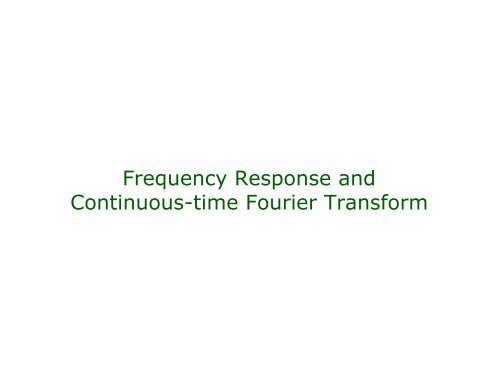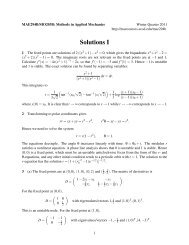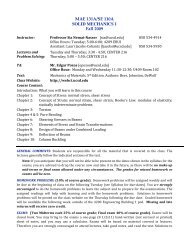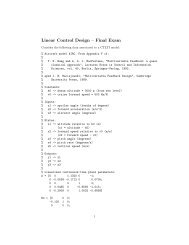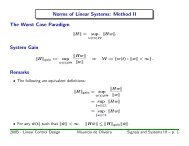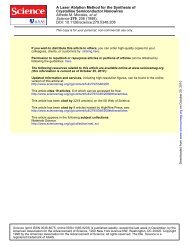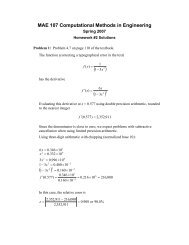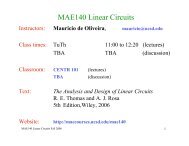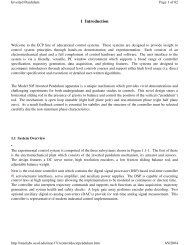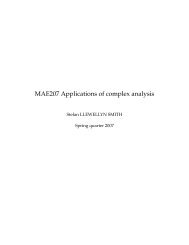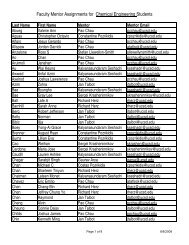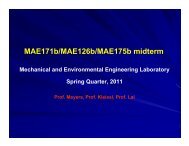Frequency Response and Continuous-time Fourier Transform
Frequency Response and Continuous-time Fourier Transform
Frequency Response and Continuous-time Fourier Transform
Create successful ePaper yourself
Turn your PDF publications into a flip-book with our unique Google optimized e-Paper software.
<strong>Frequency</strong> <strong>Response</strong> <strong>and</strong><br />
<strong>Continuous</strong>-<strong>time</strong> <strong>Fourier</strong> <strong>Transform</strong>
Goals<br />
Signals <strong>and</strong> Systems in the FD-part II<br />
I. (Finite-energy) signals in the <strong>Frequency</strong> Domain<br />
- The <strong>Fourier</strong> <strong>Transform</strong> of a signal<br />
- Classification of signals according to their spectrum<br />
(low-pass, high-pass, b<strong>and</strong>-pass signals)<br />
- <strong>Fourier</strong> <strong>Transform</strong> properties<br />
II. LTI systems in the <strong>Frequency</strong> Domain<br />
- Impulse <strong>Response</strong> <strong>and</strong> <strong>Frequency</strong> <strong>Response</strong> relation<br />
- Computation of general system responses in the FD<br />
III. Applications to audio signals<br />
- A simple design of an equalizer
Objectives<br />
How can we extend the <strong>Fourier</strong> Series method to other signals?<br />
There are two main approaches:<br />
The <strong>Fourier</strong> <strong>Transform</strong> (used in signal processing)<br />
The Laplace <strong>Transform</strong> (used in linear control systems)<br />
The <strong>Fourier</strong> <strong>Transform</strong> is a particular case of the Laplace<br />
<strong>Transform</strong>, so the properties of Laplace transforms are<br />
inherited by <strong>Fourier</strong> transforms. One can compute <strong>Fourier</strong><br />
transforms in the same way as Laplace transforms.
!<br />
!<br />
<strong>Fourier</strong> <strong>Transform</strong><br />
Generalization of <strong>Fourier</strong> Series to aperiodic functions<br />
Recall, for a periodic function of period ,<br />
$<br />
%<br />
x(t) = X[k]e jk" 0t<br />
k =#$<br />
For an aperiodic function, take<br />
x(t) = 1<br />
2" X( j#)e j#t %<br />
& ! d#<br />
1 4 4 4 4 $% 2 4 4 4 4 3<br />
!<br />
Requires x(t) to be absolutely integrable<br />
!<br />
!<br />
x(t)<br />
X[k] = 1<br />
T0 !<br />
T0 "#<br />
$<br />
%<br />
T 0<br />
2<br />
$<br />
" T0<br />
2<br />
T 0<br />
x(t)e " jk# 0 t dt<br />
X( j") = x(t)e # j"t dt<br />
1 4 4 4 #$ 2 4 4 4 3<br />
Inverse <strong>Fourier</strong> transform <strong>Fourier</strong> transform<br />
# !<br />
$ x(t) dt < #<br />
"#<br />
'<br />
)<br />
(<br />
lim<br />
1<br />
T0 " # T0 $ d% *<br />
,<br />
2& +
General signals in the <strong>Frequency</strong> Domain<br />
The signal representation in the <strong>Frequency</strong> Domain is the<br />
graph of <strong>and</strong> of<br />
One can classify signals into:<br />
!<br />
| F( j") |<br />
!<br />
"F( j#) = arctan(Im(F( j#) /Re(F( j#))<br />
Low-pass signal: The energy of the signal is concentrated<br />
at low frequencies (these signals have “slow transitions”<br />
in the <strong>time</strong> domain <strong>and</strong> are smooth)<br />
High-pass signal: The energy of the signal is concentrated<br />
at high frequencies (these signals have zero mean <strong>and</strong><br />
rapidly changing values; e.g. noise)<br />
B<strong>and</strong>-pass signal: The spectrum vanishes at low <strong>and</strong> high<br />
frequencies <strong>and</strong> concentrates in an intermediate<br />
frequency b<strong>and</strong> (signals that look more like a pure<br />
sinusoid with high frequency)
Graphical Interpretation TD versus FD<br />
Examples using cyclic frequency:<br />
Low-pass<br />
B<strong>and</strong>-pass<br />
High-pass
!<br />
!<br />
Examples: computation of FT<br />
Let’s compute the FT of<br />
$<br />
Let’s compute the FT of<br />
$<br />
x(t)= e "a|t| , Re(a) > 0<br />
X( j") = x(t)e<br />
!<br />
# j"t % dt = e<br />
#$<br />
#a|t| e # j"t % dt = e<br />
#$<br />
at # j"t % dt + e<br />
#$<br />
#at # j"t % dt<br />
0<br />
0<br />
$<br />
& 1 ) &<br />
# j" )t 1 )<br />
+ j" )t<br />
= ( e(a + # ( e#(a +<br />
' a # j" * a + j" #$ '<br />
* 0<br />
1<br />
=<br />
a # j" +<br />
1<br />
a + j" =<br />
2a<br />
a 2 +" 2<br />
$<br />
$<br />
x(t)=1<br />
X( j") = x(t)e<br />
!<br />
# j"t % dt = e<br />
#$<br />
# j"t % dt = ? Integral does not converge<br />
#$<br />
0<br />
$
!<br />
Computation of FT<br />
What do we do? Calculate FT of <strong>and</strong> then take<br />
Now,<br />
Therefore,<br />
X " ( j#) =<br />
2"<br />
" 2 +# 2<br />
!<br />
lim<br />
" # 0 X " ( j$) = 0, if $ % 0<br />
Similarly, one can also compute<br />
!<br />
!<br />
X( j") = 2#$(")<br />
!<br />
x(t)e "#t , # > 0<br />
lim<br />
" # 0 X " ( j$) = %, if $ = 0<br />
!<br />
cos(at) " #($(% & a) +$(% + a))<br />
sin(at) " j#($(% + a) &$(% & a))<br />
!<br />
&<br />
'<br />
%&<br />
" #0<br />
X " ( j#)d# = 2$
Graphical representation<br />
Observe this is the same as the <strong>Fourier</strong> Series spectrum graphs!
TD <strong>and</strong> FD representation of a signal<br />
The Time Domain <strong>and</strong> <strong>Frequency</strong> Domain representations are<br />
used to emphasize different aspects<br />
TD graph: you can see when something occurs <strong>and</strong> the<br />
amplitude of occurrence. For example, this is good for<br />
describing step or discontinuous signals<br />
FD graph: the magnitude <strong>and</strong> phase gives you information<br />
about what produces the oscillations present in the signal.<br />
Good for describing audio signals<br />
Example: sound from ringing a wine glass.<br />
The harmonics, fundamental frequency, tells<br />
us the nature of the material that produced<br />
it. This information is not contained in a<br />
single sample <strong>time</strong> of a TD description
TD versus FD: what to choose?<br />
In general, the use of TD or FD signal representations depends<br />
on the application you are working with<br />
For ECG monitors, you want to emphasize <strong>time</strong> occurrences,<br />
<strong>and</strong> produce filters that generate good step responses*. So<br />
you study <strong>time</strong> domain representations of step responses<br />
For a hearing aid, you want to emphasize certain frequency<br />
ranges, so you want to optimize your filter with respect to<br />
frequency responses. So you study frequency domain<br />
representations of audio signals<br />
Filters that perform well in terms of frequencies do not perform<br />
well in terms of step responses, <strong>and</strong> the other way around<br />
*a good step response should have a shape as close to a step as possible
<strong>Fourier</strong> <strong>Transform</strong> pairs Table<br />
A few more examples of <strong>Fourier</strong> <strong>Transform</strong> pairs from the book<br />
(Table 10.1, observe there are two columns, one for f<strong>and</strong><br />
one for )<br />
!<br />
!<br />
!<br />
!<br />
!<br />
"<br />
!<br />
!<br />
1" 2#$(%)<br />
u(t) " #$(%) + 1<br />
j%<br />
e "at u(t) # 1<br />
j$ + a<br />
cos(at) " #($(% & a) + $(% + a))<br />
sin(at) " j#($(% + a) &$(% & a))<br />
rect(t) " sinc(# /2$)<br />
sinc(t) " rect(# /2$)<br />
!
<strong>Fourier</strong> <strong>Transform</strong> properties (radian freq)<br />
Linearity<br />
Shift in <strong>time</strong><br />
Time scaling<br />
<strong>Frequency</strong> scaling<br />
<strong>Frequency</strong> shifting<br />
Modulation<br />
Differentiation<br />
Integration<br />
!<br />
!<br />
!<br />
!<br />
!<br />
!<br />
!<br />
ax(t) + by(t) " aX( j#) + bY( j#)<br />
" j$c<br />
x(t " c) # X( j$)e<br />
x(at) " 1 #<br />
X( j<br />
| a | a )<br />
x(t)e j" 1 t<br />
x( ) " X(aj#)<br />
| a | a<br />
0t<br />
# X( j(" $"0))<br />
x(t)sin" 0t # j<br />
2 X( j" + j" [ 0) $ X( j" $ j" 0) ]<br />
x(t)cos" 0t # 1<br />
2 X( j" + j" [ 0) + X( j" $ j" 0) ]<br />
t<br />
%<br />
#$<br />
d n x(t)<br />
dt n<br />
" ( j# ) n<br />
X( j#)<br />
x ( " )d" & 1<br />
X( j') + (X(0 )( j')<br />
j'
Convolution property of <strong>Fourier</strong> transforms<br />
Convolution/Multiplication duality:<br />
h(t) " f (t) = h(t #$) f ($)d$ ' H( j()F( j()<br />
#%<br />
!<br />
In particular we have<br />
!<br />
%<br />
&<br />
!<br />
h(t) f (t) " 1<br />
2# H( j$) * F( j$)<br />
F<br />
h(t) " $ # H( j%)
!<br />
!<br />
!<br />
What are the implications?<br />
For a stable linear system we can compute system responses as<br />
( )<br />
Y j" , X j" are signal <strong>Fourier</strong> transforms<br />
H( j" )<br />
is the system frequency response<br />
Spectra<br />
!<br />
!<br />
The <strong>Frequency</strong> <strong>Response</strong> contains all the information needed to<br />
determine any system response<br />
!<br />
Deconvolutions can be computed by division in the FD:<br />
y(t) = h(t) * x(t)<br />
If , then<br />
Y( j" ) = H( j" )X j"<br />
(can be done for invertible systems)<br />
!<br />
( )<br />
( )<br />
Y( j") = H( j") X( j"), #Y( j") = #H( j") + #X( j")<br />
x(t) = F "1 {Y( j#) /H( j#)}
Signals/systems in the FD<br />
Similarly to the <strong>Fourier</strong> Series case, once the input signal <strong>and</strong><br />
system <strong>Fourier</strong> transforms are computed, the response<br />
can be obtained through simple multiplication <strong>and</strong> sum<br />
operations<br />
Additionally, the FT/IFT can be approximated in a computer<br />
through special routines: the FFT (Fast <strong>Fourier</strong> <strong>Transform</strong>)<br />
<strong>and</strong> the IFFT (Inverse Fast <strong>Fourier</strong> <strong>Transform</strong>)<br />
Overall, this makes the whole process in the FD much<br />
faster than convolution in the TD. The only disadvantage<br />
is that the FT only applies to finite energy signals
Goals<br />
Signals/systems in the FD<br />
I. (Finite-energy) signals in the <strong>Frequency</strong> Domain<br />
- The <strong>Fourier</strong> <strong>Transform</strong> of a signal<br />
- Classification of signals according to their spectrum (lowpass<br />
signals, high-pass signals, b<strong>and</strong>-pass signals)<br />
- <strong>Fourier</strong> <strong>Transform</strong> properties<br />
II. LTI systems in the <strong>Frequency</strong> Domain<br />
- Impulse <strong>Response</strong> <strong>and</strong> <strong>Frequency</strong> <strong>Response</strong> relation<br />
- Computation of general system responses in the FD<br />
III. Applications to audio signals<br />
- A simple design of an equalizer
A simple design of an equalizer<br />
Applications of the <strong>Fourier</strong> <strong>Transform</strong> theory are many. One of<br />
them is the design of equalizers to accomplish different<br />
effects on audio signals:<br />
-Bass volume or low frequencies in your audio system can<br />
be implemented using a low-pass filter;<br />
-Treble volume or high frequencies can be implemented<br />
using a high-pass filter<br />
!<br />
H 1(") = " c<br />
j" + " c<br />
-The previous two filters can be combined together to<br />
filter only those sounds with frequencies around a value of<br />
!<br />
!<br />
H 2(") =<br />
H 3 (") = " c<br />
j" + " c<br />
j"<br />
j" + " c<br />
#<br />
j"<br />
j" + " c<br />
!<br />
" c
A simple design of an equalizer<br />
Example graphs of these filters for a given values of<br />
the cutoff frequencies " c#lowpass = 50000, " c#highpass =100<br />
:<br />
!<br />
!
A simple design of an equalizer<br />
Another example of b<strong>and</strong>-pass filter centered at a<br />
given frequency " 0 =1 <strong>and</strong> whose magnitude can<br />
be adjusted is the following:<br />
!<br />
(Each color<br />
corresponds to a different<br />
choice of "<br />
)<br />
!<br />
!<br />
H1(") = ( j")2 + j2" 0" /10 # 2<br />
+ " 0<br />
( j") 2 + j2" 0" $10 # 2<br />
+ " 0
A simple design of an equalizer<br />
A simple equalizer can be built by “connecting in series” b<strong>and</strong>pass<br />
filters like the previous one as follows:<br />
The center frequencies of each b<strong>and</strong>-pass filter are 20Hz, 30Hz,<br />
40Hz,…. The <strong>Frequency</strong> <strong>Response</strong> of the equalizer is obtained<br />
by summing all the b<strong>and</strong>-pass filters’ FR. By choosing<br />
different values of the parameters beta, one can emphasize<br />
or de-emphasize any frequency range in an audio signal
Important points to remember:<br />
Summary<br />
A signal can be classified into a low-pass, high-pass or b<strong>and</strong>-pass signal<br />
depending on its magnitude <strong>and</strong> phase spectrum<br />
In the <strong>time</strong> domain, low-pass signals correspond to signals with slow<br />
transitions. High-pass signals correspond to signals with fast<br />
transitions. B<strong>and</strong>-pass signals look like sinusoids/co-sinusoids.<br />
The <strong>Fourier</strong> <strong>Transform</strong> theory allows us to extend the techniques <strong>and</strong><br />
advantages of <strong>Fourier</strong> Series to more general signals <strong>and</strong> systems<br />
In particular we can compute the response of a system to a signal by<br />
multiplying the system <strong>Frequency</strong> <strong>Response</strong> <strong>and</strong> the signal <strong>Fourier</strong><br />
<strong>Transform</strong>. (And we can avoid convolution)<br />
The <strong>Fourier</strong> <strong>Transform</strong> of the Impulse <strong>Response</strong> of a system is precisely<br />
the <strong>Frequency</strong> <strong>Response</strong><br />
The <strong>Fourier</strong> <strong>Transform</strong> theory can be used to accomplish different audio<br />
effects, e.g. the design of equalizers


